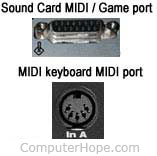MIDI

Short for musical instrument digital interface, MIDI is a standard for digitally representing and transmitting sounds that was developed in the 1980s. MIDI sound is played back through the hardware device or computer either through a synthesized audio sound or a waveform stored on the hardware device or computer. The quality of how MIDI sounds when played back by the hardware device or computer depends upon that device's capability.
Many older computer sound cards have a MIDI port, as shown in the top-right picture. This port allows musical instrument devices to connect to the computer, such as a MIDI keyboard or a synthesizer. Before connecting any MIDI devices to the computer, purchase a cable that converts the MIDI/Game port connection to the standard 5-pin DIN midi connector or a USB (Universal Serial Bus) to MIDI converter. If you don't have a MIDI port, purchase a USB to MIDI converter cable.
The file extension .mid is used to save a MIDI file.
Example of MIDI file
Below is an example of the clouds.mid file included with Windows 95 to help demonstrate a MIDI file.
Where can I buy a MIDI cable?
Below is an affiliate link with Amazon to get a MIDI cable and support Computer Hope. If Amazon isn't available in your area, we also have a link to other places to buy computer parts.
- Amazon affiliate link for a MIDI cable.
- Amazon affiliate link for MIDI cable adapters.
- Where to buy computer hardware parts.
Accessory, Cable, Computer acronyms, Connection, Data cable, DAW, Line in, MPU-401, Music, Sound terms, Synthesizer, ZIPI
